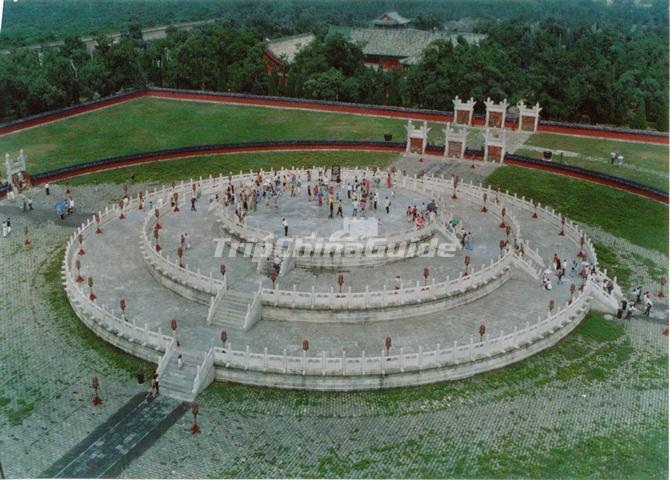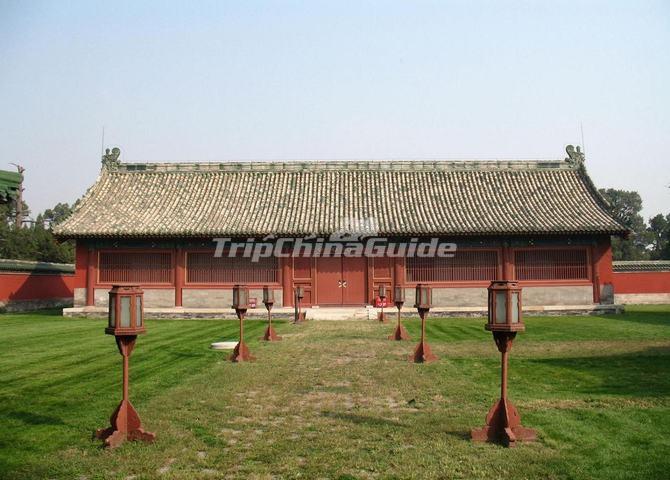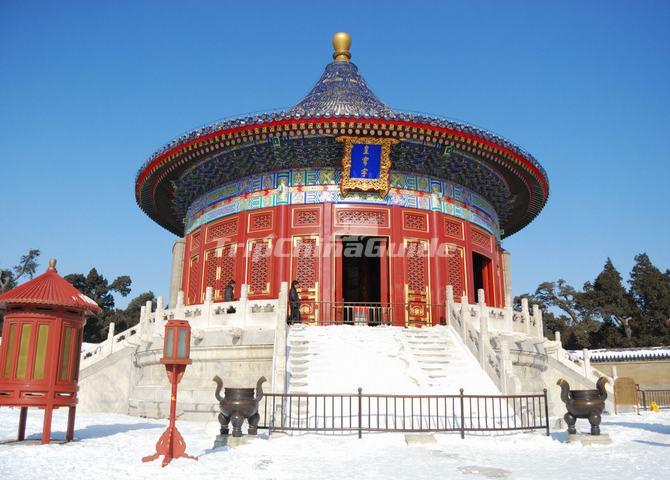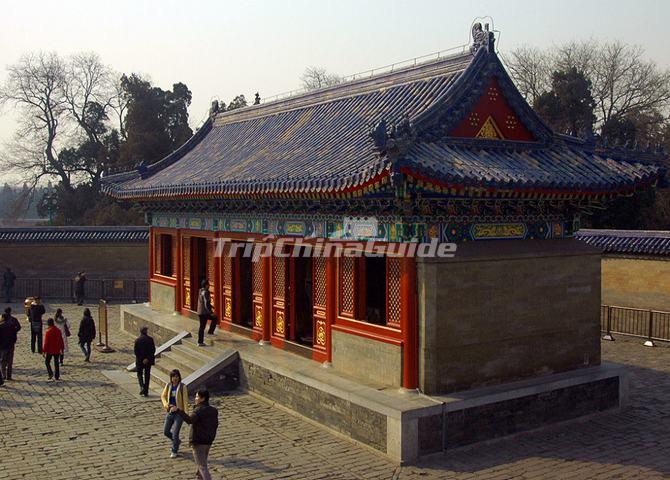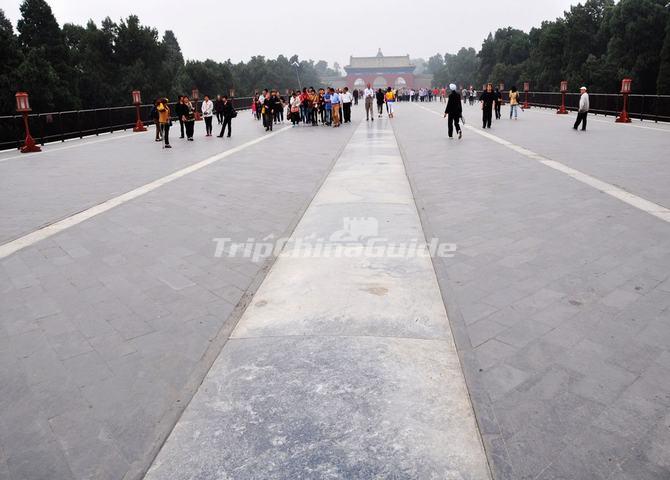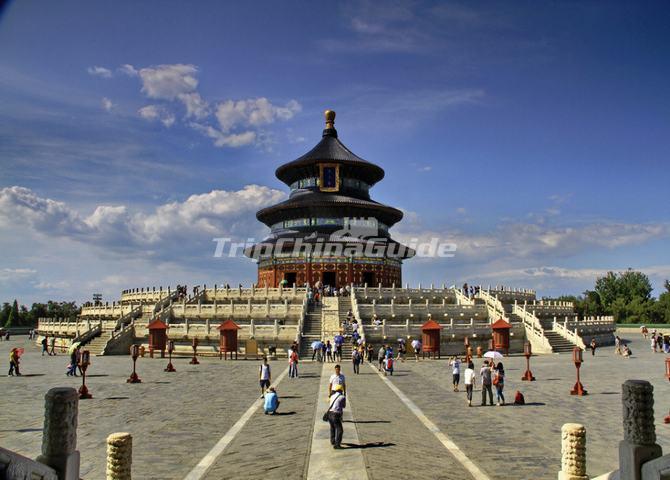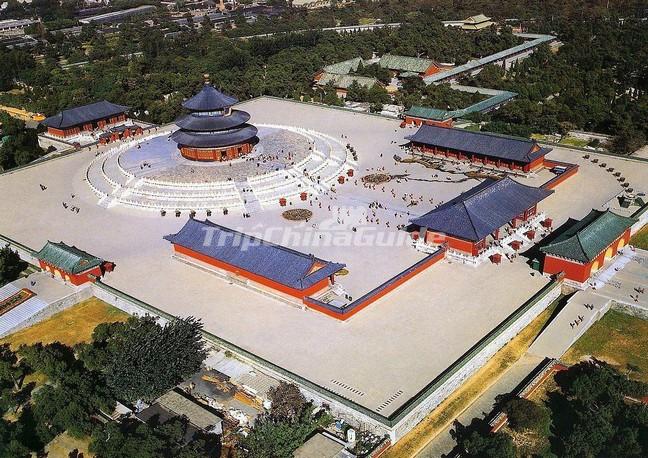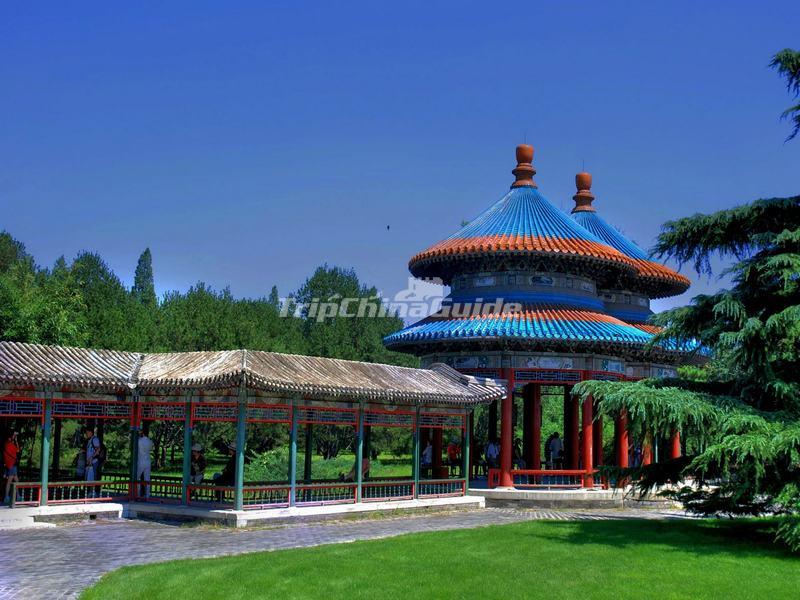Temple of Heaven
The Temple of Heaven is situated in the southern part of Beijing, about 6 km away from the center of the city. Traditionally, this temple was for imperial use only. It was built in 1420, covering an area of 237 hectares, it is the one of the largest parks in Beijing. The Temple of Heaven was the palace where the emperors of the Ming and Qing dynasties worshipped heaven and prayed for good harvest. The emperors visited the temple three times a year: on the 8th day of the first lunar month to pray for a good harvest; during the Summer Solstice to pray for rain; and during Winter Solstice to give thanks for a good harvest. During each ceremony, the emperors worshipped heaven and prayed for a good harvest. In addition, the emperors also worshipped their ancestors and other natural phenomena such as the Cloud God, Rain God and Wind God.
It is among the first key cultural sites under state protection, and in December 1998 the UNESCO inscribed it on the World Heritage List.
Circular Mound Altar
The altar seats inside the South Gate. Constructed in 1530, it is a circular stone platform of 3 tiers, 5m high, guarded with stone slabs between balustrades, encircled by a low wall of round inside but square outside as a reference to "round sky and square land". Four groups of Lingxing gates, three in a unit, stand in the four directions outside the inner and outer walls of the temple, but the Circular Mound Altar is double walled and has two rings of the gates, to form a 3-dimensional geometry that is grand and great.
Circular Mound Altar is long known as a holy, a sacred site for offering worship sacrifice. It is truly the heavenly a altar, also popularly referred to as the Altar, Altar to Worship Heaven, or Altar of Obeisance for Heaven.
Divine Court
This refers to the part storing the tablets of Supreme Ruler of Heaven and other gods, which are to be escorted to Circular Mound only for major ceremonies. The court, to the south of Circular Mound Altar inside Glaze Gate, includes mainly the Echo Wall, Imperial Vault of Heaven, east and west side halls.
Glaze Gate: It is the entrance of Divine Court, so called for its glaze brackets, the only prototype found in China, and for the glaze tiles of sky blue on its wall of finely laid bricks.
The Imperial Vault of Heaven
North of the Circular Mound Altar is the Imperial Vault of Heaven, which was originally built in 1530 and rebuilt 1752. Its structure is made from wood and brick with a blue tiled roof that is top with a gilded ball. It is 19.5 meters high and 15.6 meters in diameter. From a distance, the Imperial Vault of Heaven looks like a small version of the Hall of Prayer for Good Harvest.
As you can see, the building does not have any horizontal beams as support. The entire building is supported by 8 pillars and a span work of bars, laths and brackets, which is in complete conformity with the principles of dynamics. The decorative painted appear fresh because they were retouched in 1974.
In the center of the Imperial Vault of Heaven stands the shrine where the tablet of God of Heaven was placed. There are four stone platforms one each side where the tablets of the emperors eight ancestors were kept. During each winter solstice, these tablets were placed in a small pavilion-like cage and removed to the Circular Mound for the Worshipping Heaven ceremony. After the ceremony, the tablets were returned to the stone platforms.
Two chambers located at the front of the Imperial Vault of Heaven contained different tablets used for worship. The left chamber contained tablets of the gods of basic elements including gold, wood, water, fire and earth. The right chamber contained tablets of gods of natural phenomena including wind, rain, thunder, lighting and so on.
East and West Side Halls
The side halls, delicate with gray walls, blue titles, and painted pillars, were for tablets of the subordinate gods.
In east side hall were the tablets of God of the Sun, Five stars of Venus, Jupiter, Mercury, Mars, and Saturn, as well as the Plough, the 28 stars on the moon’s pat, etc.. Now the hall has newly added to itself the wax works of heaven worship.
In west side hall were the tablets of God of the Moon and gods of cloud, rain, and wind.
Red Stairway Bridge
The Red Stairway Bridge is a 360 meter passage that leads directly to the Gate of Prayer for Good Harvest. The bridge gradually increases in height from one end to the other. The southern end is about 1 meter high and the north end is about 4 meters high. It is 29.4 meters wide. The bridge represents the distance between the heaven and earth.
You can see three parallel paths on the bridge. Unlike other temple or the Forbidden City, the left path was reserved for the emperor. The central path was for the god of heaven while the right path was used by ministers.
The Red Stairway Bridge is called as such because there is a crossing under the bridge which was used by animals designated for sacrifice. Near the northern end of the bridge is a 150 square meter terrace which the emperor used to change his robes. A tent was set up to insure his privacy. Within the tent, a throne, incense burners and other necessities could be found.
The Hall of Prayer for Good Harvest
The highlight of the Temple of Heaven is the Hall of Prayer for Good Harvest. The hall was originally built in 1420 based on a model of the Temple of Heaven and Earth in Nanjing. At that time, it was called the Hall of Great Sacrifice. In 1530, the Temple of Earth was built in the northern part of Beijing, so only heaven was worshiped here. The hall was restored in 1751 and given its present name. In 1889, lighting caused extensive fire damage to the hall, but fortunately it was reconstructed.
The hall is cone-shaped structure with triple eaves. Originally, the triple eaves were painted in different colors. The top was blue, which symbolized Heaven, the middle was yellow to symbolize the emperor and the bottom was green to represent commoners. During the Emperor Qianlong's reign (1736 – 1795), all the eaves were painted blue to follow the color of the sky.
A six meter high, triple-tiered circular stone terrace forms the base of the structure. The hall is 32 meters high and 30 meters in diameter. In the past, the hall was one of the highest buildings in Beijing. Despite its size, only 28 massive wooden pillars support the entire structure.
A number of wooden bars, laths and brackets join the entire structure together. Steel and cement were not used. The four large pillars in the center are known as the Dragon Well Pillars with each pillar representing one of the dour seasons. The other 24 pillars are arranged in two circles surrounding the four central ones. The 12 inner pillars represent the 12 months of the year and the 12 outer pillars represent the divisions of day and night.
The ceiling framework is extremely intricate. The first or the lowest roof rests on a circular framework that is supported by the 24 outer pillars. The second roof partially rests on the 12 inner pillars and partially in the circle itself which is supported by crossbeams that are connected to the four Dragon Well Pillars. The third and highest roof rests on the four central pillars and on eight shorter pillars that are built on the same circular framework. A dragon is carved into the center of the ceiling and it represents supreme power and royalty.
A round marble stone called the dragon and Phoenix stone lies in the center of the room. Its name comes from pattern of the stone which resembles a dragon and phoenix.
The tablets o f heaven and the tablets of dead emperor are found on the platforms. The tablets of heaven are in the center. Silk fabrics, jade carvings, fruit wines and other such items were placed in front of each tablet as an offering. Also, a pig, sheep or a cow was sacrificed at each ceremony.
Rectangular, blue-roofed buildings stood on either side of the courtyard. These buildings originally served as annexes; however, the west building is now a souvenir shop and the east one is an exhibition room for all the musical instruments used in the ceremony.
The Hall of Zenith is located on the lower level north of the Hall of Prayer for Good Harvest. The tablets for the ceremony of prayer were usually kept in the Hall of Zenith. These are many wax statues that illustrate what an imperial ceremony was like.
Hall of Abstinence
The Hall of Abstinence is located near the western entrance of the Temple of Heaven. It is encircled by two walls. The Inner Wall is called Brick City, and the outer wall is called the Purple Wall. To further ensure the safety of the emperor, a moat was built to surround the Purple Wall. A bell tower, two stone pavilions and a beamless hall are the main structures here. The bell tower is in the northeast corner of the Hall of Abstinence. Before each ceremony, bells would be struck when the emperor left for the Circular Altar Mound and would not stop until the emperor arrived. After the ceremony, the bells would be struck again.
Of the two stone pavilions, the right pavilion kept time while the left one has a bronze plate with the word "fasting" engraved on it as a constant reminder to the emperor to observe fasting rules. The beamless hall was one of the most famous buildings in Beijing. A blue-title roof atop the hall symbolized that the emperor must always acknowledge the Supremacy of the Heavenly Emperor.
Double-Circle Longevity Pavilion
The pavilion is west of Hall of Prayer for Good Harvest. It structure cleverly connects two round pavilions to form a unique masterpiece. It was originally built in 1714 by Emperor Qianlong for his Mother's 50th birthday in the Imperial Palace, and in 1977 relocated here from Zhongnanhai. Nearby are Pavilion of All Flowers, Pavilion of Thousands Scenes, Sector Pavilion and so on.







